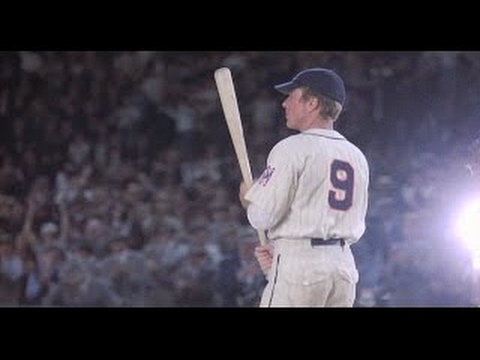Editor’s note: It’s been 35 years since the release of the Robert Redford baseball movie “The Natural” based on the novel by Benard Malumud. Having recently watched it again (the director’s cut), and the documentary made about it a few years ago, I thought I’d post this essay I wrote about it on April 18, 1988.
The production of a work of art throws light on the mystery of humanity. – Ralph Waldo Emerson
With Bernard Malamud on third base, and screenplay writers Roger Towne and Phil Dusenberry on second and first, director Barry Levinson hit a grand slam home run with his film The Natural. Through cinematic magic, the world of 1930s baseball is portrayed as larger than life. But the theme of the movie is closer to reality than myth. The tale of Roy Hobbs is a story about the mistakes, motivations, and mystery of life.
The first lesson Roy Hobbs learns in the course of the story is the nature of the mistake he made on the eve of his tryout with the Chicago Cubs. On the surface it appears his succumbing to Harriet’s seductive look was the sign that his weakness was women. Roy is attracted to a “jinxed” Memo the same way he was lured by Harriet. Before Harriet, he accepted Iris’ invitation in the barn. But Roy revealed toward the end of the movie that the true problem was beneath the surface. In the Tower Maternity scene with Roy and Iris, Roy tells her “I didn’t see it coming.” Roy said he didn’t see “it,” not “her,” coming. Because Roy was only a man, he could not see the true character of Harriet and the danger ahead. Roy found out that because he was human, life often doesn’t turn out like it’s expected.
The audience observes that Roy learned this first lesson slowly. In the Tower Maternity scene, Iris asks him, “how could you have known she was going to hurt you?” But Roy still insists that he should have seen it coming. And then Roy nearly repeats the mistake with Memo. It isn’t until Memo fires the gun in the judge’s office that Roy understands the nature of his mistake. The look of shock on his face, and his words to Memo testify to his revelation: “You were right Memo, we have met before.” Earlier he had turned on the light in that room to aggravate the Judge. This time, Memo turned the light on for Roy. Until Memo almost shot him, Roy was unable to see her true character.
Roy also had to learn about motivation. He expressed his desire to “be the best there ever was” to both Harriet and Iris. It seemed both women saw the limitation of Roy’s source of motivation. Harriet referred to something “more glorious;” Iris merely looked puzzled. But after his sixteen year sidetrack his motivation had to change. Roy resigned himself to the fact that his poor physical condition meant that “there are some mistakes we never stop paying for.” He had to be content with only being remembered for his success as a “flash in the pan.” And then, at the risk of personal scandal, his goal became saving the team for Pop Fisher. The audience could mark this lesson learned in the locker room scene where Roy talks to the coach before the big final game. Pop Fisher recalls his mother’s desire for him to be a farmer. Roy responds, not with a recital of his own motivation, but with what his father’s desire had been for him. Roy seems to have realized that the greater source of motivation was one that went beyond the selfish ego.
Harriet, Memo and Iris teamed up to teach Roy things are not always as they appear. Just as the Judge sat in the dark, so do most people. Roy learned that many mistakes are unavoidable because of man’s inability to see beneath the surface level of appearances. Barry Levinson’s use of back lighting, music and magic helps the audience to see what Roy with his human limitation was unable to until it was almost too late. But Roy had a second chance. And that aspect of the story shines light on the mystery of life itself.
Iris gave her philosophy in a sentence: “I’ve become convinced that we all have two lives — the one we learn with, and the one we live with after.” Roy was given the opportunity to avoid repeating the mistake he made by calling on Harriet: he left Memo and went back to Iris. In addition, Pop Fisher’s bad luck gave Roy the chance to correct mistaken motivation. Part of the mystery of life is that not everyone gets a second chance. In Bernard Malamud’s book, the plot is without the happy ending. Though Roy’s failure in the novel might not be as inspirational, Malamud got the rally started. The novel told of Roy’s initiation into the big leagues and into maturity. Levinson’s film helps initiate audiences into seeing that the mystery of life is often best illustrated on seventy millimeter film.

